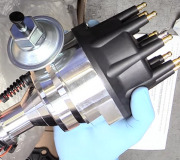Spark plug wires are the best suspect. GM ignition systems are capable of developing extremely high voltages if the spark plugs don't fire. That can be due to an overly-large plug gap, but much more commonly it's due to a burned-off terminal inside a plug wire, usually next to the spark plug, or very high resistance in the coil wire going to the distributor cap.
When that spark voltage can't get to the spark plug, it is so high, it is going to arc somewhere, and that is often inside the distributor cap. Any arcing that takes place leaves a carbon track behind, and that carbon conducts current in the future. Once current finds it easier to follow that carbon track than it does going to the spark plug, the cap or rotor is shorted.
This was a problem with GM ignition systems as far back as 1976 with their "high energy ignition", (HEI) systems. If a plug wire was pulled off to check for spark, and the distance that spark had to jump became too great, the spark would find it easier to go through the middle of the rotor, to the distributor shaft. That was called "punch through", and resulted in all the spark current being shorted to ground, and a crank/no-start.
Your Engine Computer should detect the misfire and set a diagnostic fault code indicating which cylinder is responsible. If it's the same cylinder every time, or you find a carbon track inside the distributor cap in the same place each time, that will tell you which plug wire to suspect. If you find a different cylinder is involved each time, the coil wire is the better suspect.
Tuesday, February 19th, 2019 AT 5:43 PM



